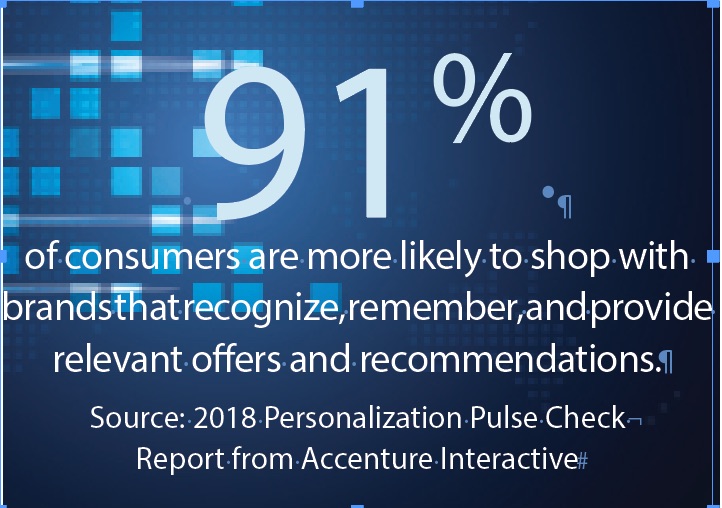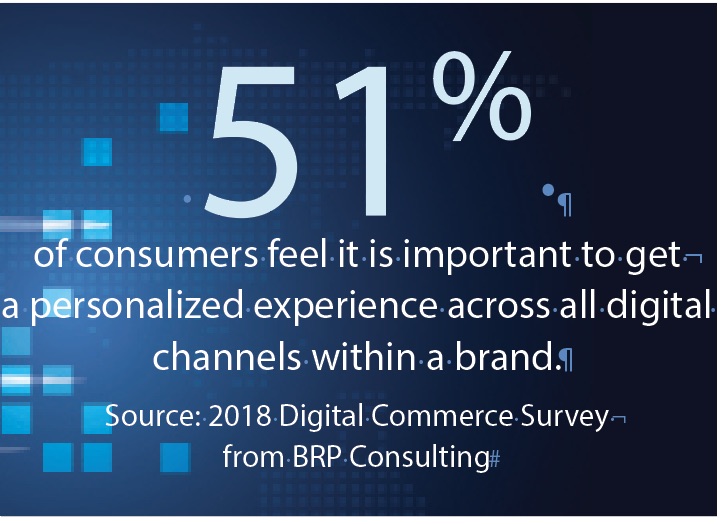Are you rethinking your retail strategy for the digital age? If not, you should. Consider the following 5 technological trends that are driving retail —and may lead consumers to your business
For more retail trends, check out the January/February issue of Sleep Savvy, where we highlighted 20 consumer, marketing and demographic developments that will impact mattress retailers in 2020 and beyond. Read What’s Next for Bedding Retailers.
If you think about the major shifts occurring in mattress retailing, you’ll discover quickly that most are driven by an underlying digital transformation.
Growth in e-commerce is behind both the popularity of boxed beds and the shuttering of brick-and-mortar stores. Meanwhile, social media and review sites have changed everything from how word-of-mouth spreads to the way consumers research products. When customers can pay with a tap of their phone, even ringing up that final sale is different. (Come to think of it, an earlier digital shift replaced mechanical cash registers with computerized systems and eliminated the actual “ringing” up of sales, even as the concept lingers in our language.)
Of course other factors have contributed to the wide variety of changes impacting retail. For instance, some of those store closures can be blamed on commercial overbuilding in the first place. But the fact remains that digital technologies — and the way that many of them are contained in a tiny computer we carry in our pockets and purses — are the biggest driver of retailing trends today.
And that, says Shelley Bransten, corporate vice president of global retail and consumer goods at tech giant Microsoft in Redmond, Washington, means “there’s never been a more exciting time to be in the retail industry.”

“With the world’s largest shopping mall in their pockets, customers are capable of making a purchase anytime, anywhere. Retailers and their brands have excelled at placing these purchase tools in their customers’ hands, but now are going even further by transforming the retail model, from the factory to the store, to align with their customers’ needs,” says Bransten in The Retail Trends Playbook 2020, a joint report from Microsoft and PSFK, a New York-based business intelligence platform.
“… In the past, technology simply helped retailers do what they’ve always done, only better, faster and more effectively. Now, retailers are embedding tech into every step along the supply chain and purchase path. Each phase of the end-to-end retail experience — starting with production and continuing into sales and repurchase — now has the opportunity to be consumer-first and personalized.”
Here we’ll examine five of the most significant retail tech trends. Some haven’t made their way into mattress retailing yet, but as consumers are introduced to new ways of shopping through other retailers, they’ll expect you to follow suit. Never forget: When it comes to consumers’ time, attention and money, you’re not just competing with other mattress sellers, but with retailers of all types of consumer goods.
1 A better back end
Let’s begin at the end — the back end of your business — and how you source and stock the products that set you apart from your competitors.
“As inventory becomes an increasingly important differentiator, stores need to leverage intelligent supply chain strategies to ensure availability of the right products at the right time to every customer,” the joint report says. (The right products at the right time: That’s a key phrase when it comes to back-end management. You’ll hear it over and over.)
For many mattress retailers, now is the time to invest in better back-end systems that will enable you to do more sophisticated data-driven analysis to improve sourcing, refine inventory management and predict consumer demand.
“Retail tech that enables the ‘behind the scenes’ action, like ensuring retailers have the right products at the right time, is critical to every merchant’s success,” according to the Retail Trends and Predictions 2020 report from San Francisco-based Vend, a provider of retail management software. (There’s that “right products at the right time” phrase again.)
And with the need to handle and process more information all the way from the back end of your business to the front end, you’ll need a network that can handle the crush of data.
“This is where 5G comes in,” the Vend report says. “5G is the fifth generation of cellular network technology. It’s fairly new, and the top major carriers in the U.S. have rolled it out in limited cities. … As carriers continue to develop the technology, forward-thinking retailers must start to adapt. Data will be accessed much more efficiently, and this will lead to more exciting and streamlined customer experiences. Think higher levels of personalization; smooth, interactive experiences; and faster processing. We’re not saying it’ll happen today or tomorrow, but any retailer who wants to stay competitive should watch this space.”

For larger retail chains and e-commerce specialists, other technological advances are making warehouses and distribution centers operate more efficiently and with fewer risks to workers’ safety.
New research indicates that by the end of this year, more than 100,000 autonomous mobile robots will be helping to fulfill retail orders in the United States — and that excludes the robots at fulfillment centers operated by automation pioneer Amazon. The number of robots is expected to grow to a whopping 580,000 by 2025, according to Interact Analysis, a U.K. company with U.S. offices in Austin, Texas.
“This automation can significantly reduce order processing times. In addition, warehouses have struggled to find enough human laborers to keep up with demand, so automated systems are an attractive solution. Automated warehouses help improve inventory control. Rather than wait for manual inventories, smart robotics and computer systems keep reliable stock data in real time. This accurate data helps retailers manage stock flow (and) make solid predictions, smart decisions and forecasting that help improve the store’s bottom line,” says Bernard Marr in a November 2019 article for Forbes. Marr is an author, speaker, futurist, and strategic business and technology adviser based outside London.
Smaller independent retailers may not have need for warehouse robots, but automated stock management will impact you, too. Vendors who incorporate such systems into their operations will be able to provide you products more efficiently and, if you take advantage of their drop-ship capabilities, will be able to fulfill your customers’ orders more quickly, too.
2 Getting the data
As we noted, the need for better data doesn’t stop at the warehouse door. The more information you can gather about your customers, their preferences and their habits, the better you can serve them.
“Retail is one industry that particularly stands to gain from data collection as companies look to learn all they can about their customers’ needs,” writes Keara Dowd, web editor for BizTech magazine in a December 2019 article. Point-of-sale data and website cookies already provide a vast amount of information about shoppers’ buying behaviors, but retailers now have another tool in their toolkit, the internet of things.
“The rise in IoT has forced industries to take notice; it’s estimated that by next year, there will be 30 billion IoT devices in operation. According to McKinsey Global Institute, these devices will have an economic impact on retail of between $410 billion and $1.2 trillion by 2025,” Dowd writes.
How can IoT help you? In everything from automated checkouts to smart shelves and flooring — and all as a way to gather more information about consumers to create a more personalized and more efficient shopping experience.
“We have witnessed a moderate uptake of beacons, RFID and WiFi solutions to track and trace in-store behaviors, and they have gleaned great insight and results for those who have experimented. The next wave of tracking technology takes things a step further, literally. …Smart flooring and carpets will find their ways into retail environments and under the feet of oblivious shoppers, enabling the monitoring of footfall and movement patterns with millimeter accuracy,” according to Retail Trends 2020 and Beyond, a report from The Behaviours Agency, a Manchester, England-based marketing firm.

And here is another place where trend watchers say retail data collection is headed: “Supplementing these smart underlays will be facial recognition technology,” The Behaviors Agency report says. “Privacy issues aside, used to good effect, this analytic addition will enable stores to recognize returning customers and personalize their shop appropriately with tailored recommendations and rewards. … It also has the potential to be used to determine demographic and even physical data, identifying gender and age, as well as height and body shape. Taking things a step further, this technology will not only be used to identify customers but also their emotions. Integrated into shelves, rails and displays, it will read the expression and reactions of shoppers as they browse, gauging sentiment as they move through a store.”
Retail experts argue that consumers already have shown they are willing to trade privacy for more tailored shopping experiences.
As the amount of information you can collect on consumers grows, organizing all of that data becomes more important than ever, and that means investing in technology that can help you sort, analyze and act on everything you’ve amassed.
“Not only will (retailers) need tools like customer relationship management systems to keep it all straight, but they’ll also need to be able to analyze and visualize all that information,” Dowd says.
Platforms such as Splunk and Microsoft’s Power BI offer dashboards and other tools to make it easier to understand the information you collect.
3 Finding it faster
Back-end improvements and better data collection ultimately help consumers, but let’s look at some digital tools they can use directly as they shop.
Websites, search engines, robust review sites and social media already have transformed the way consumers research, select and buy products, Dowd says. The latest step in the evolution is visual search.
“Online shoppers have long been frustrated trying to put together the right combination of keywords to find the item or style they’re searching for. Over the past few years, visual search technology has revolutionized that process, allowing shoppers to take a picture of an article of clothing, upload it to an engine like Google Images and use that to drive the search with artificial intelligence,” she says.
Dowd cites a survey from visual search firm ViSenze that found nearly two-thirds of Generation Z and millennial consumers want to use visual search to shop. “Companies who want to target younger consumers will have to incorporate it,” she says.
For consumers who arrive at your e-commerce site and still have some questions about products, customer service bots, or chat bots, will be increasingly important. Like the rise of visual search, this too is driven by generational shifts. Younger consumers would much rather text than call a store or customer service line.
“There has been rapid adoption of messaging-based customer service bots across retail. At least 50% of the Fortune 5000 have experimented with and tested out bots,” Marr says. “Messaging has become the preferred customer service channel.”
Chat bots can answer presale questions from consumers and address post-sale issues quickly — and without wasting staff time on common, repetitive queries. As the artificial intelligence and technologies behind chat bots improve, Marr says, retailers will see fewer abandoned carts on their e-commerce sites and happier customers.
4 New realities
Augmented and virtual realities can take gamers deeper into the field of play. They also can train surgeons and pilots to better perform their jobs. At retail, AR and VR (sometimes lumped together and called extended reality) can help consumers see how a new shade of lipstick will look or how a pair of pants will fit.
Furniture retailers, such as Ikea, are using extended reality to let consumers test how a new sofa or dining table will look and fit in a room. Just think how you could boost sales of larger mattress sets if your customers could use extended reality to confirm that upgrading from a flat queen set to an adjustable king would work in their bedroom.
“Extended reality also can provide additional information for customers when they are browsing for products, such as the Living Wine Labels from Treasury Wine Estates,” Marr explains. Consumers can scan the company’s AR-enabled wine labels with their smartphones to learn about a wine’s notes or the history of the vineyard. (Wine drinkers can download the Living Wine Labels app for iOS and Android for use with labels for several wine brands. This includes Walking Dead Wines, which really “come to life.”)
“It’s becoming more accessible for retailers to incorporate AR/VR … with platforms that specialize in helping stores build their virtual worlds,” Dowd says. “With a clear demand for convenience from customers, as well as advancements to make the technology more affordable, expect to see (these technologies) used a lot more in 2020.”
5 “How would you like to pay for that?”
It’s been a long time since “Cash, check or charge?” was a routine query at store checkout counters. (These days, when you see someone whip out a checkbook, it’s like a trip back in time to when telephones had cords and TVs didn’t come with remotes.)
Today, payment methods are diversifying and evolving more quickly than ever, with online payment services (like PayPal), mobile wallets (like Apple Pay, Google Pay and Samsung Pay) and peer-to-peer payment apps (like Venmo) becoming increasingly popular. Mattress retailers need to keep up.
For grocers, drug stores, big boxes and other retailers where long lines can annoy customers, many of these new payment options are attractive because they help speed up checkout times, but mostly they are about customer convenience and preference. And once consumers become accustomed to using a particular payment method at the gas station or on Amazon, they want to use it wherever they can, including at mattress e-commerce sites and brick-and-mortar stores.
The Vend report notes that nearly half of “smartphone owners use peer-to-peer payment apps regularly” and “around 2.1 billion consumers worldwide are expected to use mobile wallets for payments or money transfers” this year.
“Retailers need to take a proactive approach to the consumer demand for app-based payment methods. … And while things like Google Pay, Apple Pay, Android Pay and Afterpay will continue to rise in popularity, don’t forget about PayPal, which has more experience processing mobile payments than many other big-name providers,” the Vend report says. “The company has partnered with Google and Alibaba, among others, and has started to use Venmo (which it owns) for more than just a social media-friendly money transfer platform.” (Afterpay, by the way, is an app that allows consumers to “shop now, pay later in four interest-free installments.”)
Hand in hand with the burgeoning number of payment options is a rise in “all-in-one platforms to handle financial transactions, security and banking needs,” writes Jennifer Spencer, chief executive officer of Bethesda, Maryland-based public relations firm Energent Media in an October 2019 article for Entrepreneur. Examples include comprehensive business intelligence platforms, such as those offered by Cyfe and Tableau, as well as financial services and infrastructure services like those from Prime Trust, Spencer says.
“Consumers and business owners alike appreciate the ability to accomplish more than one of their goals with a particular vendor, and these comprehensive systems are gaining popularity,” Spencer says. “…As the demand for diverse payment methods grows, these types of full-service banking and financial platforms will be necessary for even small businesses or storefronts. Customers want contactless credit options and the ability to pay with cryptocurrency or their phone. They also demand high security and instant, 24-hour access to funds. Having experts guide your business through this ever-changing financial maze will be crucial moving forward.”
Stay tech savvy
The through line in all these innovations is a digital transformation that enables retailers to be more responsive to consumers’ needs. And for you as a mattress retailer to remain relevant, you’ll need to embrace the technological advances your customers seek and even expect.
As the Microsoft and PSFK report puts it: “Technology within the retail space has primarily served to ensure transactional moments were quick and efficient. Now, retailers have an unprecedented opportunity to go a step further and leverage data-driven and digital technologies to elevate the customer experience in more meaningful ways. From creating new products to delivering specialized campaigns, machine learning, analytics and other technologies are empowering brands and retailers to understand their shoppers better and deliver differentiated 1:1 experiences.”
Technology To-Dos
Here’s a checklist of steps you can take to use technological advancements to improve your retail business. The to-dos come from The Retail Trends Playbook 2002 from Redmond, Washington-based tech giant Microsoft and PSFK, a New York-based business intelligence platform.
- Explore how partner technologies can be tailored to address your employees’ most common and labor-intensive challenges.
- Decide what data to solicit from shoppers, both online and in-store. Avoid data overloads by identifying key questions and appropriate metrics to collect and analyze.
- Consider how information is displayed to ensure it’s digestible and actionable for retail sales associates and managers.
- Provide RSAs with hands-on training for the tools and technologies they will use in their day-to-day roles.
- Use machine learning to track what consumers purchase and return, enabling you to refine your inventory and even merchandising.
- Augment the power of predictive algorithms with customer feedback and qualitative analysis for thorough, balanced forecasts.
- Compare customer data across all channels to glean insights that can inform merchandising, store flows and other processes.

Julie A. Palm is chief wordsmith at Palm Ink LLC in Winston-Salem, North Carolina. She has 25 years of experience as a writer and editor for newspapers and magazines and as a publications director. She is a past editor in chief of both Sleep Savvy and BedTimes magazines. She can be reached at japalm623@gmail.com.






